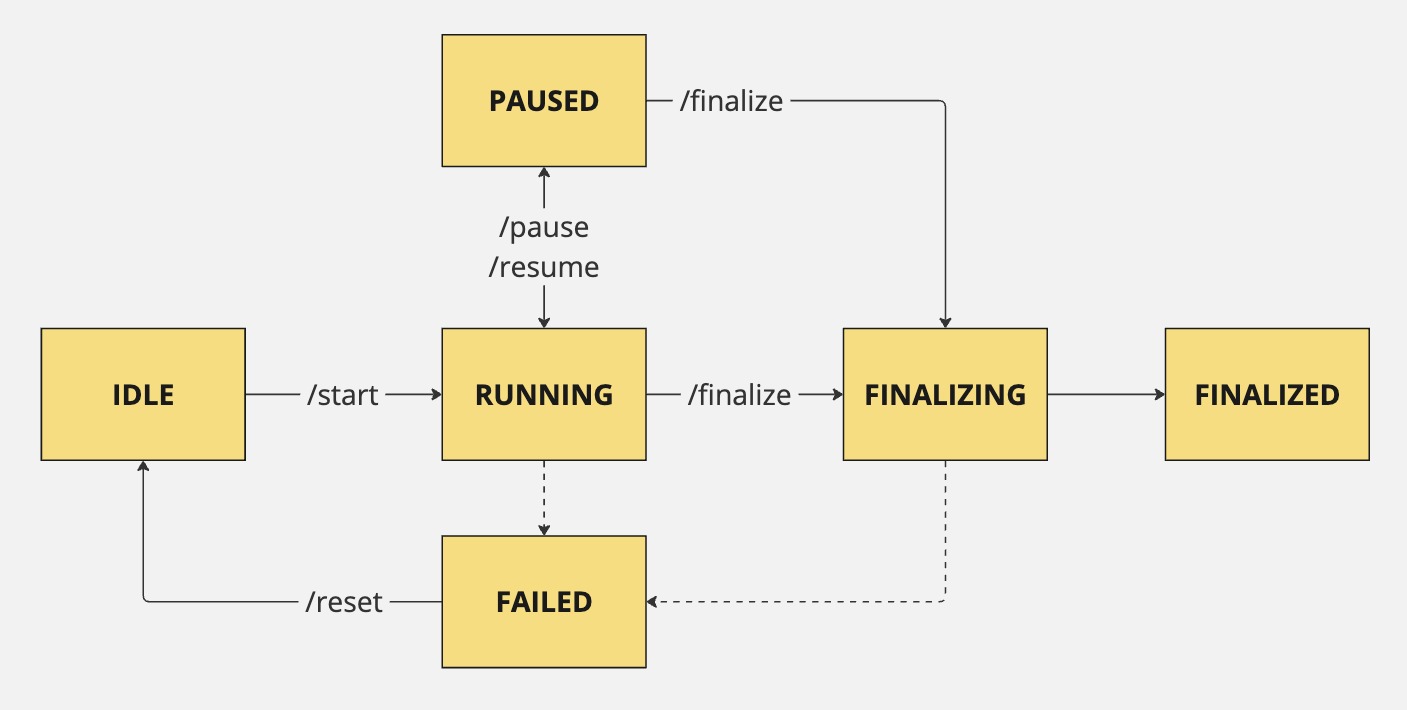How Percona Link for MongoDB works¶
Percona Link for MongoDB (PLM) is a binary process that replicates data between MongoDB deployments in real time until you manually finalize it. You can also make a one-time data migration from the source to the target with zero downtime.
You operate with Percona Link for MongoDB using the set of commands or API calls. Depending on the request it receives, Percona Link for MongoDB has several states as shown in the following diagram:
- Idle: PLM is up and running but not migrating data
- Running: PLM is replicating data from the source to the target. PLM enters the running state when you start and resume the replication
- Paused: PLM is not running and data is not replicated
- Finalizing: PLM stops the replication and is doing final checks, creates indexes
- Finalized: all checks are complete, data replication is stopped
- Failed: PLM encountered an error
Usage scenario¶
Now, let’s use the data migration from MongoDB Atlas to Percona Server for MongoDB as an example to understand how PLM works.
You run a MongoDB Atlas 8.0.8 deployed as a replica set. You need to migrate to Percona Server for MongoDB 8.0.8-3, also a replica set. You have a strict requirement to migrate with zero downtime; therefore, using logical backups with Percona Backup for MongoDB is a no-go.
A solution is to use Percona Link for MongoDB. MongoDB Atlas is your source. An empty Percona Server for MongoDB replica set is your target. Data migration is a resource-intensive task. Therefore, we recommend installing PLM closest to the target to reduce the network lag as much as possible.
Create users for PLM in both MongoDB deployments. Start and connect PLM to your source and target using these user credentials. Now you are ready to start the migration.
To start the migration, call the start command. PLM starts copying the data from the source to the target. First it does the initial sync by cloning the data and then applying all the changes that happened since the clone start.
After the initial data sync, PLM monitors changes in the source and replicates them to the target at runtime. You don’t have to stop your source deployment, it operates as usual, accepting client requests. PLM uses change streams to track the changes to your data and replicate them to the target.
You can pause the replication and resume it later. When paused, PLM saves the timestamp when it stops the replication. After you resume PLM, it copies the changes from the saved timestamp and continues real-time replication.
You can track the migration status in logs and using the status command. When the data migration is complete, call the finalize command. This makes PLM finalize the replication, create the required indexes on the target, and stop. Note that finalizing is a one-time operation. If you try to start PLM again, it will start data copy anew.
Afterwards, you will only need to switch your clients to connect to Percona Server for MongoDB.
Filtered replication¶
You can replicate the whole dataset or only a specific subset of data, which is a filtered replication. You can use filtered replication for various use cases, such as:
- Spin up a new development environment with a specific subset of data instead of the whole dataset.
- Optimize cloud storage costs for hybrid environments where your target MongoDB deployment runs in the cloud.
Specify what namespaces - databases and collections - to include and/or exclude from the replication when you start it.
Next steps¶
Ready to try out PLM?
Created: September 8, 2025
